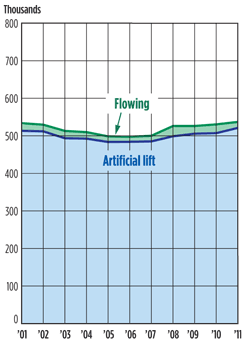|
The total number of producing oil wells in the U.S. increased at a steady pace in 2011, reflecting stepped-up drilling programs spurred by $100/bbl prices. World Oil’s estimate of producing wells, based on surveys of state agencies and company sources, indicates a rise of over 16,000 wells to 535,951. This is up 3.2% over 2010. It should be pointed out that the quality and reliability of data varies from state to state, but, overall, the regional figures represent reasonably accurate counts.
Texas continues to lead the nation in the sheer number of viable producing wells with over 156,000 and counting. The largest number of wells is in Railroad District 8 in West Texas, where there is vigorous activity in both vertical and horizontal drilling. The greatest increase was in District 1 of south-central Texas, where the Eagle Ford shale oil plays have attracted a flurry of drilling activity.
| Estimated U.S. wells producing oil at the end for 2011, by region |
 |
Following Texas, in decreasing order of well count, are Oklahoma, Kansas, California and Ohio. Together, these five states hold 70% of the nation’s oil wells. (The Oklahoma well count, with estimates from 80,000 to over 100,000, is a looser number than most, based on multiple sources. The Oklahoma Corporation Commission is currently updating the state’s well database, so future figures promise to be more accurate.)
Generally, the Mid-Continent region (including Oklahoma, Kansas, Nebraska, North Dakota and South Dakota) saw a 3.3% gain in producing wells. North Dakota accounted for the bulk of these new producers, as the drilling boom in the Williston basin added new oil wells at a rapid pace, and high prices kept mature ones profitable. All told, North Dakota gained some 1,370 net oil wells, a staggering increase considering there are just 6,400 reported for the entire state. Since the pace of Bakken shale drilling is rising in the new year, we expect total wells to continue climbing.
The greatest increase came in the Rocky Mountains region, led by New Mexico with a jump of some 3,400 wells. The majority of those wells were in the mature-but-still-prolific Permian basin oil plays in the southeastern counties. Besides new wells added, high oil prices resulted in fewer old, low-producing wells being shut in. In the same general region, Colorado added another 1,200 net wells, an 11.6% increase over 2010. Also, Wyoming reported a similar rise of 1,200 wells. Both of these Rocky Mountain states are overlapped by the Niobrara shale plays, which have excited interest in recent years because they are liquids-rich.
 |
| Estimated U.S. oil producing wells |
|
In the Midwest region, both Illinois and Indiana saw their well counts fall. Illinois reported some 14,868 oil wells were producing at the end of 2011, down from 15,384 a year earlier. Indiana saw its producing wells drop by over 500 wells to 4,529. Increased activity in Michigan’s mature oil fields, again inspired by high crude prices, raised that state’s oil well count over 6% to 4,150 (although overall production continues to fall).
On the West Coast, California saw its oil well count rise to 48,609, a 1.2% increase over 2010, almost all onshore. This reversed a recent trend, and partially made up for a significant decline from 2009. Alaska showed a net increase of 16 wells to 1,772.
In the East Coast region, available data points toward greater emphasis on oil and less emphasis on gas, with fewer low-producing, or “stripper,” wells being shut in, and more oil wells being drilled, particularly in the Utica shale plays. Pennsylvania, the nation’s oldest oil province, has a large number of small and family-owned wells that add minute amounts of crude to the state total, but they are not technically counted as producers, according to the Pennsylvania Department of Environmental Protection’s oil and gas bureau.
In the Gulf of Mexico, expectations of a decline have not been proved out, and the region saw a healthy increase of 99 wells to 2,887, despite a drilling slowdown that followed the Macondo oil spill.
Based on the states for which World Oil was able to obtain a breakout of flowing wells versus those on artificial lift, the percentage of U.S. oil wells produced by artificial lift is staying steady at about 95%. That ratio has remained fairly constant throughout the past 10 years. 
|




